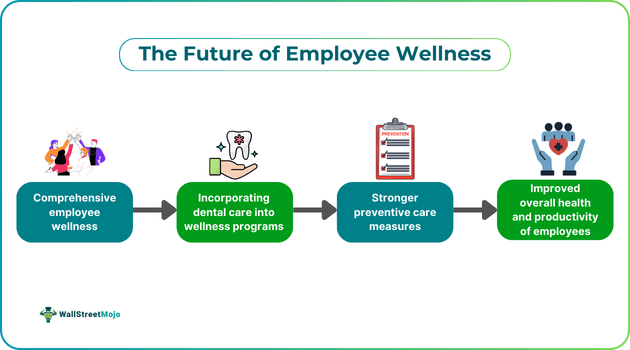Table of Contents
Introduction
Creating a work environment in which well-being thrives should be a top priority for all employers. In fact, with employee engagement improving with time, looking after the physical, emotional, and mental wellness of people is key to business success in the long term. Traditionally, employee wellness has often been limited to yearly medical checkups, mental health support, and nutrition. While these factors are crucial, the future of employee wellness is not just limited to them. Today, reputed companies are focusing on more components that contribute to wellness with the purpose of making employees healthier.

Per the latest workplace wellness trends, the overall approach is much more progressive and involves critical elements of one’s health that were overlooked previously, for example, dental care. Indeed, poor oral health does not just impact one’s physical well-being. It can significantly impact one’s mental health in the workplace, which can lead to poor productivity.
Why Preventive Care Matters?
Preventive care has played a crucial role in employee wellness programs over the years, as it minimizes healthcare costs for both employees and employers via the early detection of diseases. Whether it is periodic health screenings or personalized checkups, preventive care can minimize the possibility of chronic illnesses and help spot potential health problems early. Companies that integrate preventive healthcare in their employee well-being strategy usually record less absenteeism and benefit from enhanced employee morale and engagement.
Having said that, traditionally, dental care has often been overlooked with regard to preventive care. That’s why, in many cases, issues like teeth misalignment and cavities used to result in complications and addressing such issues is generally a costly affair. That said, over time, companies have realized the importance of a proactive approach concerning oral health. As a result, they have now incorporated it into their corporate wellness programs.
Encouraging employees to take quick action, like searching for a dentist near me and booking an appointment, can prevent long-term complications and unnecessary stress.
Overlooked Connections in Health
Another important aspect concerning the future of employee wellness is the consideration of connections that have been overlooked in the past. For instance, sinus infections can cause pressure that feels like tooth pain. Without the right awareness, such symptoms can be misinterpreted, leading to delayed treatment and prolonged discomfort.
Thus, one should remember that the well-being of employees is beyond just treating symptoms that are visible. Focus should be put on comprehending how different parts of the body may impact each other. One should keep in mind that overlooked links with regard to oral care include its connection with diabetes, cardiovascular disease, respiratory infections, and even Alzheimer’s. Maintaining optimal dental health allows one to function properly. Moreover, it is vital for human relationships and communication. Those failing to ensure optimal oral health can experience pain and may even have to incur significant costs for treatment later on.
Thus, recognizing the overlooked connections should be a vital part of the present as well as the future of employee wellness to ensure that the issues are identified and eliminated as early as possible before they turn into serious concerns.
Building the Wellness Programs of Tomorrow
Businesses must focus on certain aspects when building such programs, keeping in mind the future of employee wellness. To begin with, there must be clarity regarding the definition of the term ‘wellness.’ Indeed, when employers and employees have a mutually agreed-upon definition and both are on the same page, designing a program becomes easier. This definition captures the program’s vision and dictates every policy-related decision.
Moreover, it gives more clarity regarding the type of actions required to enhance employee wellness. For example, it may include opening a daycare center, providing lunch allowance, etc. On the other hand, if employees and employers operate on the basis of assumptions, both might end up getting disappointed.
Note that building a wellness program for employees requires employers to ensure flexibility so that it can meet the dynamic requirements of modern workers. It is ideal that employees have no fixed work schedules to ensure work-life balance, which, in turn, can result in better well-being. In addition, employers must take measures to offer adequate mental health support and stress management tools so that they can ensure optimal health conditions and maintain high energy levels. Such factors play a key role in ensuring an optimal level of productivity.
Lastly, organizations must make sure to consider dental care as a crucial part of their wellness program. They can arrange for periodic check-ups and educate employees with proper resources to make them aware of the potential health hazards resulting from poor dental care.
Designing comprehensive programs that take into account all these aspects should be a set standard for companies worldwide to secure the future of employee wellness. Undoubtedly, these initiatives will support both professional growth as well as personal growth of employees and benefit organizations.
